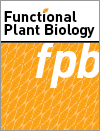Leaf senescence and plant growth are crucial for crop health and yield. This study shows that the NtDHS–NteIF5A complex in Nicotiana tabacum regulates these processes by controlling the translation of genes involved in chlorophyll metabolism and cell growth. The discovery of this translational regulation provides new insights into plant biology, offering potential strategies for improving crop performance by manipulating the balance between growth and aging in plants.

Functional Plant Biology
Volume 52 Number 3 2025
Our study determined that druse synthesis in a xerophytic plant species constitutes an adaptation to drought, not to herbivory. Under drought stress conditions, higher druse abundance correlated with increased growth rates. In contrast, the presence of herbivory did not induce druse synthesis, and its presence influenced the response to drought stress. Our findings highlight the role of druses in the adaptive response to drought and reveal how interactions with other common stressors, such as herbivory, can modify this response.
Although the rise in temperature has been intensively studied, the associated effect of air humidity and vapour pressure deficit (VPD) on trees must be clarified. We investigated the impact of these factors on Norway spruce (Picea abies) saplings and discovered that the higher temperature alone does not affect trees, while the interaction with VPD rise improved tree functioning. These findings suggest that aside from temperature, the impact of air humidity should be considered by predicting trees’ response to global warming.
Semi-arid regions have abundant light and heat, concentrating agricultural activities. However, high temperatures and drought conditions pose significant constraints on crop productivity. Our study found that an optimal Se application enhanced the acquisition traits in eggplants, thereby maximising photosynthetic gains and achieving a ‘high input – rapid return’ model in terms of leaf construction costs and photosynthetic efficiency. Our findings suggest that Se application can serve as a crucial strategy to enhance crop productivity in semi-arid environments.
The existence of C3- and C4-types of photosynthesis enables plant to better adapt to different environment conditions including diverse temperature regimes. The current study revealed differences between C3-plant barley and C4-plant maize in mechanisms limiting activity of photosystems I and II. These results increased the biophysical component that is underrepresented in the general understanding of distinctions between C3- and C4-types of photosynthesis.
We applied a systems biology approach to gain a deep insight into the regulatory mechanisms of barley (Hordeum vulgare) under drought and waterlogging stress conditions. The identified gene modules, enriched pathways, and regulatory networks provide valuable insights into the complex molecular responses of barley to drought and waterlogging stresses. This comprehensive analysis significantly contributes to our understanding of the genetic and regulatory mechanisms underlying stress responses in barley.





